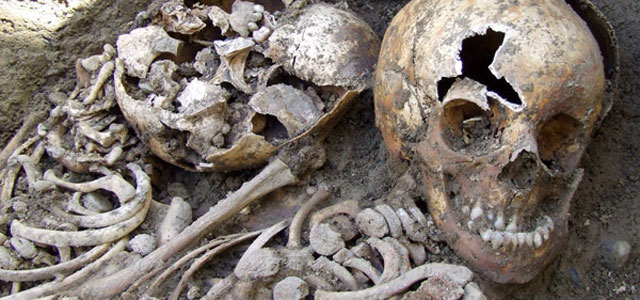Forensic Case Files: Famine and Death at an Irish Workhouse
/
The Irish Potato Famine took place between 1845 and 1852 when a severe potato blight ravaged Northern Europe. It is believed that potatoes carrying the microorganism Phytophthora infestans carried the blight from North America’s eastern coast to Europe in 1844, where it then spread. In 1845, half of Ireland’s single strain potato crop was lost to the blight; three quarters was lost in 1846 and the first starvation deaths were recorded. A staple food for both the farmer and the poor, some families depended almost solely on the potato to stave off starvation. Paired with the vitamins and protein in milk, the twelve to fourteen pounds of potatoes consumed per person per day provided a relatively balanced, albeit uninteresting, diet. But with their crops dying by the acre, many families had no chance of survival. And even though the majority of Ireland’s lands produced enough grain to feed its starving people, this was considered a cash crop and Ireland continued to export thirty to fifty shiploads of food to Britain daily while their own people died by the thousands. By the time the famine finally ended, over one million Irish had succumbed to starvation and related diseases, while another million had emigrated, many coming to North America.
In 2005, a worker for a local archeology consulting firm, Kilkenny Archaeology, discovered human remains on the site of the old Kilkenny Union Workhouse. Excavations started the following year, and 63 mass graves were uncovered, each holding the remains of 6 to 27 deceased for a total of over 970 dead. Out of that 970, 545 were children under the age of 6.
The Kilkenny Union Workhouse opened in 1842, following the creation of the Poor Law Act. It became home to over 1,300 poor souls, providing food and shelter in exchange for backbreaking and brutal labour producing clothes and blankets by hand. But as the famine continued, the number of people seeking refuge at the workhouse skyrocketed, and by 1851 it housed over 4,300 inhabitants—more than three times its intended maximum population.
With so many residents housed inside its walls, the workhouse buildings were extremely overcrowded and became a prime incubator for diseases such as cholera, typhoid and consumption. The final stressor came when a typhus outbreak struck in 1847. Because of a recent ban from burying paupers in local cemeteries, the workhouse constructed an unconsecrated cemetery on their own property. Due to the number of inhabitants dying each day, there was no choice but to use a system of mass graves to manage the dead, creating and closing one grave per week.
Over half of the recovered remains show signs of scurvy, a disease caused by a lack of vitamin C; for the Irish, this need would have usually been filled by the potatoes in their diet. Without that component, the bones showed a range of characteristic clues:
- severely low mineral content
- thinning of the cortex (the hard outer layer of bone that provides the majority of structural support)
- epiphyseal separation in young victims (a reversal of the normal process of epiphyseal fusion)
- holes in the skull at the temples and around the teeth.
The bones tell a heartbreaking story of starvation and suffering. But they also speak of redemption, as many of these osteological signs only come about during the recovery from scurvy. Clearly many of the dead had survived near starvation to begin their recovery at the workhouse, only to die from typhus in their still weakened state in the overcrowded ranks of the workhouse.
One thing to note about the mass graves—the dead were buried with care. Compared to mass graves in war zones like Srebrenica, where bodies were carelessly tossed on top of each other, the Irish remains were carefully shrouded and laid in simple pine coffins. The coffins were then neatly stacked in the mass graves before being finally filled in. Sometimes family were buried together, a parent and child or siblings interred together in a single coffin.
In May 2010, a reburial ceremony was held, consecrating the ground as part of the new Famine Memorial Garden.
Photo credit: Bioarchaeologist Dr Jonny Geber, University College Cork



 COMPLETE!
COMPLETE! Planning
Planning